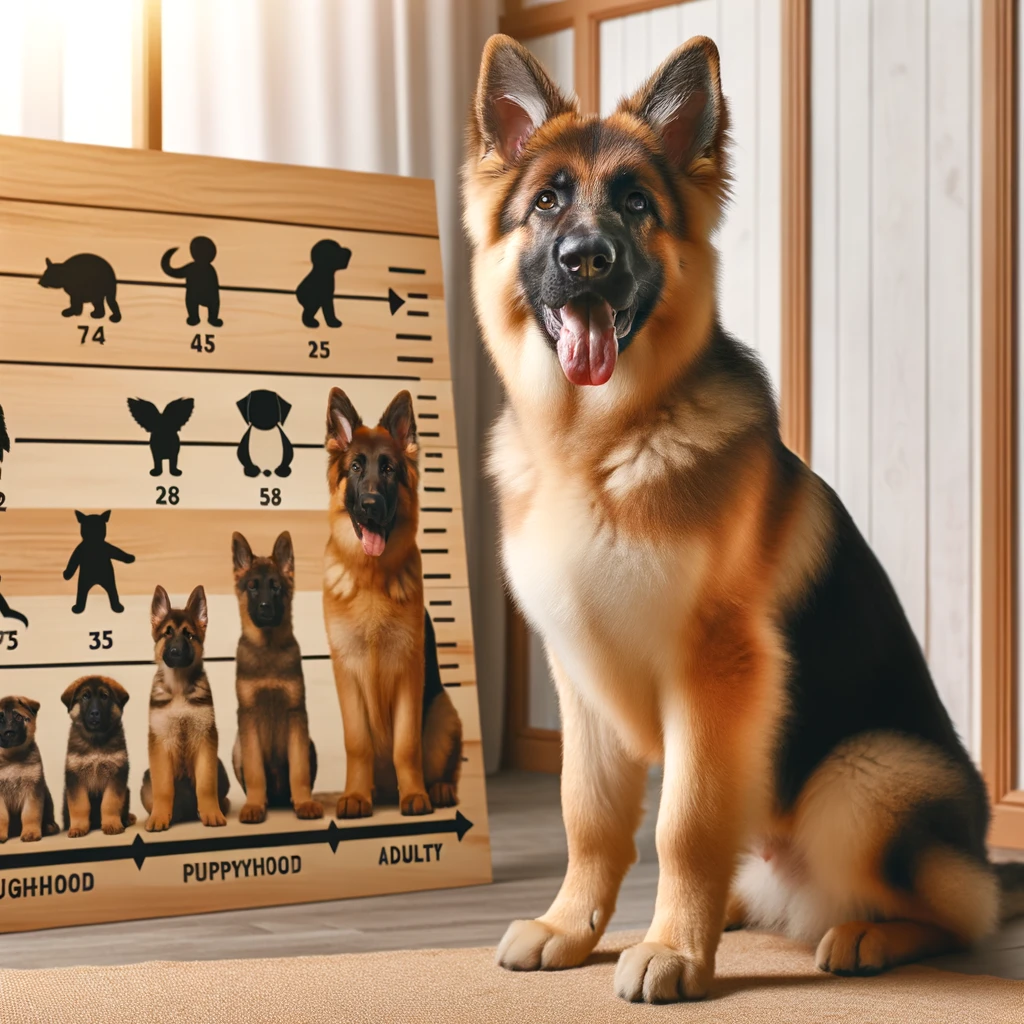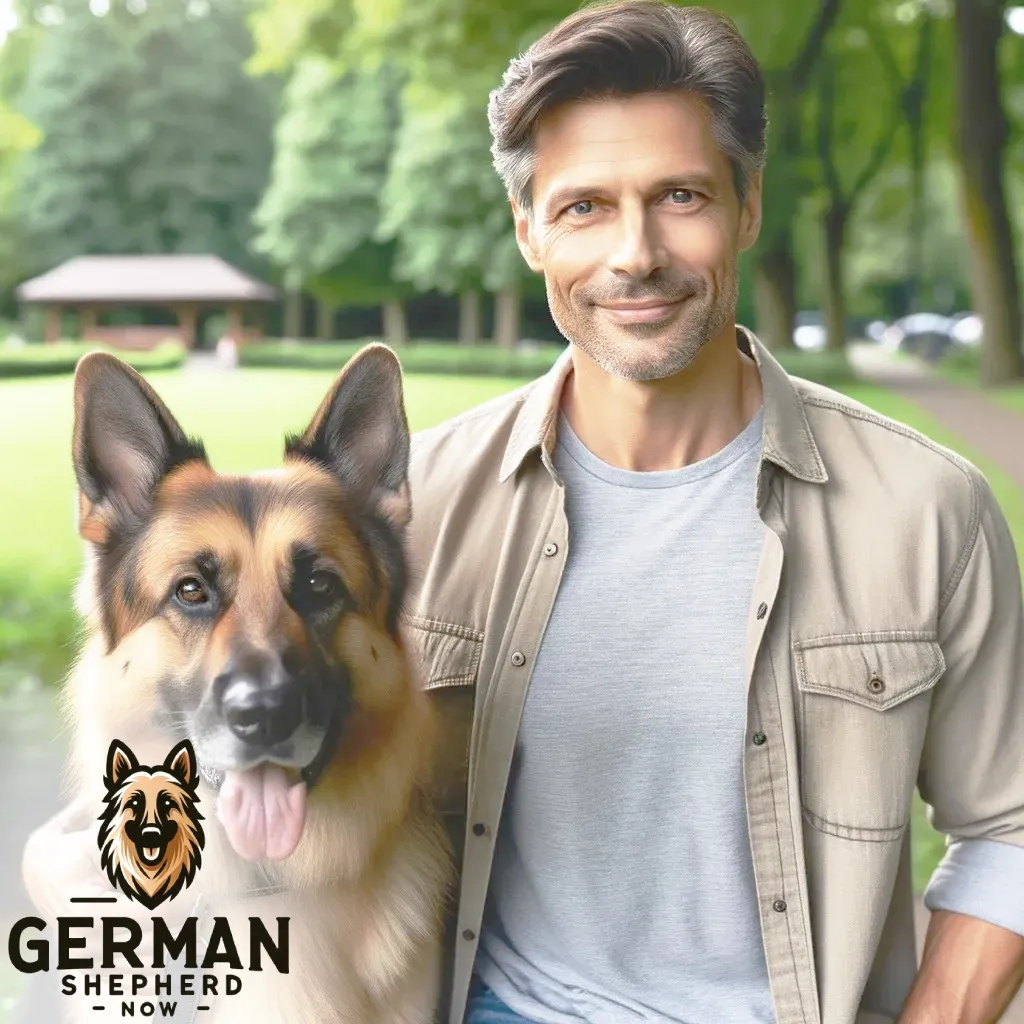When Does A German Shepherd Stop Growing

A German Shepherd stops growing at about 18 to 24 months old. Their growth rate is rapid during the first six months when they gain much of their height.
Between 6 and 12 months, they continue to grow but slowly. By 18 to 24 months, they usually reach their full size, although some may continue to fill out in muscle and width until they are about 2 to 2.5 years old.
German Shepherd Growth Stages
German Shepherds, known for their intelligence and versatility, go through distinct stages of growth from puppyhood to adulthood.
Understanding these stages is crucial for owners to provide appropriate care and training. This breed experiences rapid changes in size, behavior, and physical abilities, each stage presenting unique challenges and milestones.
By recognizing and adapting to these phases, owners can ensure their German Shepherd develops into a well-adjusted, healthy adult.
Puppyhood (0-6 Months)
In the first six months, German Shepherd puppies experience rapid growth. They are playful, curious, and energetic, requiring ample nutrition to support their fast-developing bodies. This period is critical for socialization and early training.
Exposure to various environments, people, and other animals is essential to prevent fear and aggression later in life.
Puppies will reach about half their adult size during this stage but still have a lot of growing to do.
Adolescence (6-12 Months)
The adolescence stage sees a German Shepherd continue to grow but at a slower rate compared to the initial six months. This period is characterized by increased independence and testing boundaries. Training and socialization must continue to reinforce good behavior.
Owners might notice a surge in energy levels and the need for more structured exercise and mental stimulation.
The breed’s protective instincts often emerge during this stage, requiring careful guidance to ensure they do not become overly territorial or aggressive.
Young Adulthood (12-18 Months)
By this stage, a German Shepherd will have reached close to their full height, but they will continue to fill out in muscle and breadth.
Young adult Shepherds are more coordinated and have a higher capacity for focused training. This is an excellent time to engage them in advanced training or dog sports.
Their temperament stabilizes, but they still require consistent leadership and exercise to manage their high energy levels. It’s also a crucial period for strengthening the bond through training, play, and consistent routines.
Maturity (18-24 Months and Beyond)
A German Shepherd reaches physical maturity between 18 and 24 months. They will have attained their adult size and weight, though some may continue to fill out until they are about 2.5 years old.
Their temperament is well-established at this stage, making them dependable and predictable. Mature Shepherds excel in various roles, including companionship, work, or sport.
Continuous mental and physical stimulation remains vital to keep them happy and healthy. Proper diet, regular health check-ups, and consistent training and exercise will ensure a well-balanced adult dog.
Growth Chart for Male German Shepherds
Male German Shepherds are renowned for their strength, intelligence, and versatility. Significant physical and behavioral changes mark their growth journey from puppyhood to adulthood.
It’s important to remember that individual dogs may vary due to genetics, diet, and health. Regular veterinary check-ups are essential to monitor their growth and overall well-being.
Generally, male German Shepherds are larger compared to their female counterparts.
| Age | Weight Range | Height Range | Developmental Milestones |
| 1 Month | 5.5 – 9 lbs (2.5 – 4 kg) | 7 – 10 inches (18 – 25 cm) | Initial exploration, early socialization |
| 2 Months | 16 – 20 lbs (7.3 – 9 kg) | 11 – 14 inches (28 – 36 cm) | Beginning of vaccinations, more active |
| 3 Months | 22 – 30 lbs (10 – 14 kg) | 14 – 17 inches (36 – 43 cm) | The rapid growth phase, the start of basic training |
| 4 Months | 31 – 40 lbs (14 – 18 kg) | 16 – 18 inches (41 – 46 cm) | Teething starts, increasing independence |
| 6 Months | 40 – 57 lbs (18 – 26 kg) | 18 – 20 inches (46 – 51 cm) | Nearing adult height, developing social skills |
| 9 Months | 49 – 68 lbs (22 – 31 kg) | 20 – 23 inches (51 – 58 cm) | Growth slows, and adolescent behaviors emerge |
| 12 Months | 60 – 80 lbs (27 – 36 kg) | 21 – 24 inches (53 – 61 cm) | Approaching adult size, onset of maturity |
| 18 Months | 65 – 85 lbs (29 – 39 kg) | 22 – 25 inches (56 – 64 cm) | Reaches full height, continues to gain muscle |
| 24 Months | 66 – 88 lbs (30 – 40 kg) | 23 – 26 inches (58 – 66 cm) | Fully grown, physically and mentally mature |
Growth Chart for Female German Shepherds
Female German Shepherds, known for their intelligence and loyalty, follow a distinct growth curve from puppyhood to adulthood.
Remember that individual dogs may vary slightly due to genetics, nutrition, and overall health.
Regular check-ups with a veterinarian are essential to ensure they are growing healthily. It’s important to note that female German Shepherds grow slightly smaller than their male counterparts.
| Age | Weight Range | Height Range | Developmental Milestones |
| 1 Month | 4.5 – 8 lbs (2 – 3.6 kg) | 6 – 9 inches (15 – 23 cm) | Beginning to explore, initial socialization starts |
| 2 Months | 11 – 17 lbs (5 – 7.7 kg) | 11 – 14 inches (28 – 36 cm) | Vaccinations begin, more active play |
| 3 Months | 17 – 26 lbs (7.7 – 12 kg) | 14 – 17 inches (36 – 43 cm) | Rapid growth, basic training starts |
| 4 Months | 22 – 33 lbs (10 – 15 kg) | 16 – 18 inches (41 – 46 cm) | Teething, increased independence |
| 6 Months | 33 – 49 lbs (15 – 22 kg) | 18 – 20 inches (46 – 51 cm) | Close to adult height, social behavior forms |
| 9 Months | 42 – 59 lbs (19 – 27 kg) | 20 – 22 inches (51 – 56 cm) | Slower growth, adolescent behaviors |
| 12 Months | 49 – 71 lbs (22 – 32 kg) | 21 – 23 inches (53 – 58 cm) | Nearing adult size, maturity begins |
| 18 Months | 50 – 73 lbs (23 – 33 kg) | 22 – 24 inches (56 – 61 cm) | Full height reached, continues to fill out |
| 24 Months | 50 – 75 lbs (23 – 34 kg) | 22 – 24 inches (56 – 61 cm) | Fully grown, physical and temperamental maturity |
Factors Affecting German Shepherd Growth
German Shepherds are a popular and versatile breed known for their intelligence, strength, and loyalty.
While genetics primarily determine their size and growth rate, several external factors significantly influence their development from puppyhood to adulthood.
Understanding these factors is essential for owners to ensure their German Shepherds reach their full potential in a healthy and balanced way.
Genetics
Genetics is the most significant factor in a German Shepherd’s growth. The size of a dog’s parents usually indicates how large the dog will become. Inherited traits can also influence growth rate, overall health, and physical attributes.
Nutrition
Proper nutrition is crucial for healthy growth. Puppies require a diet rich in proteins, vitamins, and minerals to support their rapid development. Overfeeding or underfeeding can lead to health issues like obesity or malnutrition, impacting the dog’s growth and overall health.
Health and Medical Conditions
Various health conditions can affect a dog’s growth. Parasitic infections, heart problems, or hormonal imbalances like hypothyroidism can impede growth. Regular veterinary check-ups are vital to identify and treat any health issues early.
Exercise
Exercise is essential for muscle development and overall health. However, too much exercise, especially in puppies, can lead to joint problems since their bones are still developing. Adequate and appropriate exercise helps in achieving balanced growth.
Spaying/Neutering
The timing of spaying or neutering can impact growth. Dogs neutered early tend to grow taller as the closure of growth plates is delayed. However, this can lead to joint issues later in life. It’s important to consult a vet to decide the best procedure time.
Environment and Social Conditions
A dog’s environment and social experiences can indirectly affect its growth. Chronic stress or lack of socialization can lead to health and behavioral issues, which in turn can impact physical development.
Conclusion: Nurturing the Growth of a German Shepherd
The growth of a German Shepherd, culminating between 18 and 24 months, is a complex process influenced by genetics, nutrition, health, exercise, spaying/neutering, and environmental factors.
From rapid development in puppyhood to gradual maturation into adulthood, each stage presents unique challenges and milestones.
Owners must understand and adapt to these phases to ensure their German Shepherd grows into a well-adjusted, healthy adult.
Proper care, regular veterinary check-ups, balanced nutrition, and appropriate training are key to fostering their physical and mental development.

I’m Martin, and I grew up in the super cool city of Seattle. You know, the place with all the incredible mountains and forests? Yeah, that’s my playground!
Ever since I was little, I’ve been all about nature. I used to wander around the woods with a notebook, doodling all the cool plants and animals I’d find.
